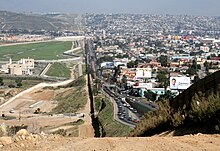El Salón México
El Salón México is a symphonic orchestral work by the American composer Aaron Copland (1900–1990) that uses Mexican folk music extensively .
The work
Copland had visited Mexico several times in the 1930s. His work on the plant began in 1932 but was not completed until 1936. The one-movement work is a representation of a dance hall of the same name in Mexico City and has the subtitle “Popular Type Dance Hall in Mexico City”. The world premiere took place in 1937 by the Mexican Symphony Orchestra under the direction of Carlos Chávez ; it had its American premiere in 1938.
According to the publisher, it has a playing time of 12 minutes, but is often played faster. During a trip to Mexico, Copland had visited the then famous dance hall El Salón México in Mexico City and then collected several songs and dance numbers and reworked and arranged them into an atmospheric and varied orchestral piece. Leonard Bernstein compared the dance hall in his introduction to the piece at the Aaron Copland Birthday Party in 1960 in the New York Philharmonic Young People's Concerts series with the " Roseland " (in New York City ).
Orchestral line-up
The work is published by Boosey & Hawkes . The orchestra is (according to the publisher's information):
2.picc.2.corA (ad lib) .2.Ebcl (ad lib) .bcl (ad lib) .2.dbn (ad lib) -4.3 (2) .3.1-timp.perc: xyl / cyms / brush /guiro/tpl.bl/wdbl/BD/SD/tab-pft-strings
To the formation
The composer notes about the atmosphere in which the piece was created:
"Perhaps my piece might never have been written if it hadn't been for the existence of the Salón México. I remember reading about it for the first time in a tourist guide book: 'Harlem-type nightclub for the peepul [ sic in the source quoted], grand Cuban orchestra. Three halls: one for people dressed in your way, one for people dressed in overalls but shod, and one for the barefoot. ' When I got there, I also found a sign on the wall which said: 'Please don't throw lighted cigarette butts on the floor so the ladies don't burn their feet.'
[...] In some inexplicable way, while milling about in those crowded halls, one really felt a live contact with the Mexican people - the atomic sense one sometimes gets in far-off places, of suddenly knowing the essence of a people - their humanity , their separate shyness, their dignity and unique charm. "
various
The piece was conducted by many famous conductors, including Toscanini, including Copland himself, for example at the New York Philharmonic's Aaron Copland birthday party on his 60th birthday.
A piano arrangement was made by the composer Leonard Bernstein , also one for two pianos and one for four hands.
For the musical film Fiesta (1947, German under the title: Mexican Nights ), the work was adapted and orchestrated as Fantasia Mexicana by Johnny Green , interpreted by André Previn .
literature
- Douglas Lee: Masterworks of 20th-Century Music: The Modern Repertory of the Symphony Orchestra. Routledge, New York / London 2002, ISBN 0-415-93846-5 , pp. 118 ff. ( Limited preview in Google book search).
Web links
- New York Philharmonic conducted by the composer (at the Aaron Copland birthday party, 1960) on YouTube
- Piano arrangement by Leonard Bernstein (sheet music) on YouTube
- Ricardo Montalban - Desde "El Salón Mexico!" (from 0:01:08) on YouTube (excerpt from the film Mexican Nights )
- Copland: El Salon Mexico
- unimusik.uni-hamburg.de (program booklet)
- El palo verde on YouTube , La Jesusita on YouTube , El mosco on YouTube , El malacate on YouTube (Mexican folk songs)
References and footnotes
- ↑ See e.g. B. the duration of the recordings of Copland (New York Philharmonic); Toscanini etc.
- ↑ boosey.com - in shorthand
- ↑ Aaron Copland. El Salón México . Archived from the original on March 4, 2016. Retrieved January 8, 2019.
- ^ Aaron Copland: The Story Behind my El Salon Mexico. In: Tempo, No. 4 (Jul., 1939), pp. 2-4, JSTOR 943608
- ^ Toscanini, NBC 1942 on YouTube
- ↑ Sound sample on YouTube
